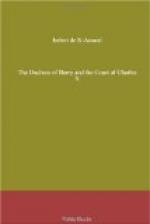“Paris, 2d of March.
“The ball given at the Pavilion Marsan, in the apartments of the Children of France, was honored by the presence of the King, M. the Dauphin and Madame the Dauphiness. Mgr. the Duke of Orleans and his family arrived at eight o’clock.
“Tomorrow there will be a play at the Court Theatre; the actors of the opera will play La Muette de Portici.”
Beside the persons who figure in the album of M. Eugene Lamy many others were to be noted. Let us mention the Countess Hemi de Biron, the Marchionness Oudinot, the Countess de Noailles, who represented Margaret of Savoy, Claude Duchess of Lorraine, the Princess de Conde, the Princess of Ferrara; the Count A. de Damas, as Lanoue Bras-de-Fer; Monsieur de San Giacomo, as Francois de’ Medici; the Countess de Montault, as Countess de Coligny; the Marchioness de Montcalm, as the Duchess de Bouillon; the flower of the English aristocracy,—Lady Aldborough, Lady Rendlesham, Lady Cambermere, Lady Vernon, Lord Ramlagh, Captain Drummond, Lord Forwich, Lord Abayne, Miss Caulfuld, Miss Thelusson, Miss Baring, Miss Acton, and, lastly, the Counts de Cosse de Biron, and de Brissac, representing the three marshals of France whose names they bore.
In donning the costume of the unfortunate queen whose sorrows could only be compared to those of Marie Antoinette, the Duchess of Berry proved how free her mind was from all gloomy presentiments, forgetting that the family of the Bourbons had already had its Charles I., and not foreseeing that it was soon to have its James II., the amiable Princess hardly suspected that in the course of next year, she would be an exile in Scotland in the castle of Mary Stuart.
XXV
THE FINE ARTS
From 1824 to the end of the Restoration, the department of the Fine Arts, connected with the ministry of the King’s household, was confided to the Viscount Sosthenes de la Rochefoucauld, son of the Duke de Doudeauville. He was then at the head of the museums, the royal manufactures, the Conservatory and the five royal theatres,—the Opera, the Francois, the Odeon, the Opera-Comique, and the Italiens.
From the point of view of arts and letters the reign of Charles X. was illustrious. The King encouraged, protected, pensioned the greater number of the great writers and artists who honored France. What is sometimes called in literature the generation of 1830 would be more exactly described as the generation of the Restoration. This regime can claim the glory of Lamartine, as poet. A body-guard of Louis XVIII., he was the singer of royalty. He published, in 1820, the first volume of his Meditations Poetiques, in 1823 the second, and in 1829 the Harmonies. His literary success opened to him the doors of diplomacy. He was successively attache of the Legation at Florence, Secretary of Embassy at Naples and at London, Charge d’Affaires in Tuscany. When the Revolution of 1830 broke out, he had just been named Minister Plenipotentiary to Greece.




